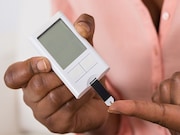Findings seen for initial injectable therapy with insulin degludec plus liraglutide versus insulin glargine
FRIDAY, June 14, 2019 (HealthDay News) — Compared with insulin glargine, initial injectable therapy with a combination of insulin degludec and liraglutide aids achievement of blood glucose goals for a longer period of time in patients with uncontrolled type 2 diabetes on oral antidiabetic drugs, according to a study published online June 9 in The Lancet Diabetes & Endocrinology to coincide with the annual meeting of the American Diabetes Association, held from June 7 to 11 in San Francisco.
Vanita R. Aroda, M.D., from Brigham and Women’s Hospital in Boston, and colleagues randomly assigned patients (1:1) to either IDegLira (insulin degludec 100 units/mL plus liraglutide 3.6 mg/mL in a 3-mL prefilled PDS290 pen for subcutaneous injection) or IGlar U100 (insulin glargine 100 units/mL in a 3-mL prefilled Solostar pen for subcutaneous injection), with each treatment being an add-on to existing therapy. Treatments were given once daily, at a time of the patients’ choosing for 104 weeks (Jan. 8, 2016, to Oct. 3, 2018).
The researchers report that 484 of 506 patients in the IDegLira group and 481 of 506 patients in the IGlar U100 group completed the trial. At baseline, overall mean diabetes duration was 10 years. Compared with those in the IGlar U100 group, patients in the IDegLira group had significantly longer time until treatment intensification was needed (median, about one year versus more than two years). Additionally, during the study period, fewer patients in the IDegLira group needed treatment intensification versus the IGlar U100 group (37 versus 66 percent; hazard ratio, 0.45). There were no new or unexpected safety and tolerability issues and no treatment-related deaths.
“In patients who did not need treatment intensification, IDegLira provided a greater treatment effect, with more patients achieving HbA1c of less than 7.0 percent (<53 mmol/mol), HbA1c of less than 7.0 percent (<53 mmol/mol) without weight gain, a lower estimated mean insulin dose, and lower rate of severe or blood glucose-confirmed symptomatic hypoglycemic events per patient year of exposure versus IGlar U100," the authors write.
Several authors disclosed financial ties to pharmaceutical companies, including Novo Nordisk, which manufactures liraglutide and funded the study.
Copyright © 2019 HealthDay. All rights reserved.








